
Home |
About Us |
How to Participate |
Biodiversity Modules |
Projects |
Maps |
News |
Resources

Home |
About Us |
How to Participate |
Biodiversity Modules |
Projects |
Maps |
News |
Resources
|
Definition of "Wetlands" - General Code 500: Vegetated areas where plants are rooted in water or water saturated soil or that regularly tolerate flooding for extensive time periods. |
Wetlands: Shrub-steppe Marsh (522)
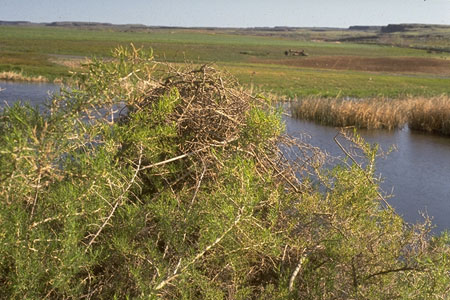 | |
| Descriptive Habitat Code: This wetland (5) is a freshwater marsh (2) and emergent vegetation (2). | |
| Photo:KMD | |
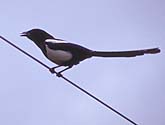 Black-billed magpie Pica pica Code: PIPI Photo: RA |
Distribution and Habitat: It is found in shrub steppe, sparsely wooded, and treeless areas in the Columbia Basin. Diet: Interesting
fact: |
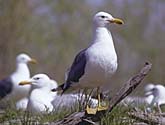 California gull Larus californius Code: LACAL Photo: RA |
Distribution and Habitat: It is found throughout parts of the western North Pacific Ocean. It breeds on gravel beds along the Columbia River and large lakes in the Columbia Basin. Diet: Interesting fact: |
 Coyote Canis latrans Code: CALAT |
Distribution and Habitat: It is found in mountainous areas, grasslands, deciduous and mixed coniferous forests and even urban areas. Diet: Interesting fact: |
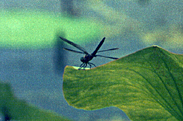 Dragonfly Photo: KB |
Distribution and Habitat: Found in wetlands throughout the world. Diet: Interesting fact: |
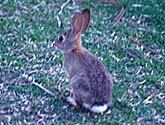 European cottontail Oryctolagus cuniculus Code: ORCU Photo: KMD |
Distribution and Habitat: It is native to parts of Europe and northwest Africa. It is only known to occur on nine of the islands in San Juan County, WA. The Eastern cottontail has been introduced to Washington and is found in most habitats except medium/high development, estuaries, and closed-canopy forests. Diet: Interesting fact: |
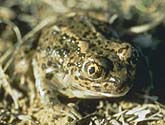 Great Basin spadefoot toad Spea intermontana Code: SPIN Photo: WDFW |
Distribution and Habitat: It is found in semi-arid shrublands, dry woodlands, and other areas where it lives in the underground burrows of gophers, etc. Diet: Interesting fact: |
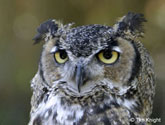 Great horned owl Bubo virginianus Code: BUVI Photo: TFK |
Distribution and Habitat: It is found across the state in cliff areas. Diet: Interesting
fact: |
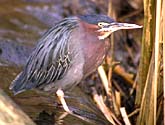 Green heron Butorides striatus Code: BUST Photo: RA | Distribution and
Habitat: The green heron is found in secluded wetlands, wooded sloughs, and along slow-moving water in ditches. Diet: Interesting fact: |
 Mallard Anas platyrhynchos Code: ANPL |
Distribution and Habitat: It is found in wetlands, lakes, ponds, rivers, estuaries and coastal marine areas. Diet: Interesting fact: |
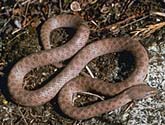 Night snake Hypsiglena torquata Code: HYTO Photo: TM |
Distribution and Habitat: It is found in a variety of habitats including deserts, woodlands, mountain meadows, grasslands, chaparral, sagebrush flats, and also in both rocky and sandy areas. Diet:
Interesting
fact: |
 Northern leopard frog Rana pipiens Code: RAPI Photo: BL |
Distribution and Habitat: It is found from sea level to over 11,000 feet, in ponds, lakes, streams, wetlands and other permanent bodies of standing water. Diet: Interesting
fact: |
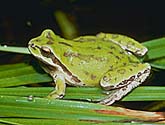 Pacific treefrog Hyla regilla Code:PSRE Photo: WDFW |
Distribution and Habitat: It is found throughout the Pacific Northwest, never too far from small ponds. Diet: Interesting fact: |
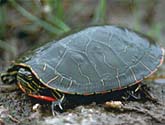 Painted turtle Chrysemys picta Code: CHPI Photo: WDFW |
Distribution and Habitat: It is found in wetlands, lakes, ponds and rivers. Diet: Interesting fact: |
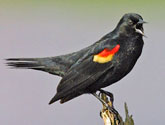 Red-winged blackbird Agelaius phoeniceus Code: AGPH Photo: Natures Pics |
Distribution and Habitat: It is found in wetland areas. Diet: Interesting fact: |
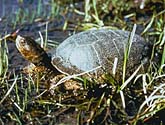 Western pond turtle Clemmys marmorata Code: CLMA Photo: WDFW | Distribution
and
Habitat: It is found in marshes, ponds, streams, rivers, wetlands and ditches. This turtle is primarily found in open canopy forests, such as oak woodlands. It will be found in conifer wetlands that have open meadows and grasslands nearby. Diet: Interesting
fact: |
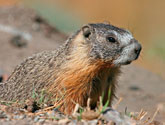 Yellow-bellied marmot Marmota flaviventris Code: MAFL Photo: Natures Pics |
Distribution and Habitat: It is found throughout parts of eastern Washington in semi-arid habitats. Diet: Interesting
fact: |
Home |
About Us |
How to Participate |
Biodiversity Modules |
Projects |
Maps |
News |
Resources